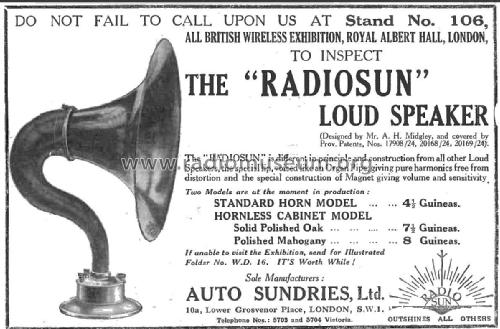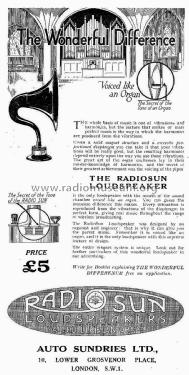Radiosun Loudspeaker Cabinet Model
Radiosun (Brand), Auto Sundries, Ltd.; London
- Land
- Grossbritannien (UK)
- Hersteller / Marke
- Radiosun (Brand), Auto Sundries, Ltd.; London
- Jahr
- 1923–1926
- Kategorie
- Lautsprecher, Kopfhörer oder Ohrhörer
- Radiomuseum.org ID
- 346420
- Hauptprinzip
- NF-Verstärkung
- Wellenbereiche
- - ohne
- Betriebsart / Volt
- Keine Stromversorgung
- Lautsprecher
- Trichter
- Material
- Gerät mit Holzgehäuse
- von Radiomuseum.org
- Modell: Radiosun Loudspeaker [Cabinet Model] - Radiosun Brand, Auto Sundries,
- Form
- Standgerät: allgemein.
- Bemerkung
-
Hornless Cabinet Model
- Solid Polished Oak - 7½ guineas
- Polished Mahogany - 8 guineas
The whole basis of music is one of vibrations and harmonics, but the feature that makes or mars perfect music is the way in which the harmonics are produced from the vibrations. Given a solid magnet structure and a correctly proportioned diaphragm, you can take it that your vibrations will be really good, but the resulting harmonics depend entirely upon the way you use those vibrations.
The great art of the organ craftsmen lay in their master knowledge of harmonics, and the secret of their greatest achievement was the voicing of the pipes the Radiosun loudspeaker is the only loudspeaker with the mouth of the sound chamber voiced like an organ.
You can guess the immense difference this makes. Every intonation is reproduced from the vibrations of the diaphragm in perfect form, giving real music throughout the range of wireless broadcasting.
The RadioSun Loudspeaker was designed by an organist and engineer: which is why it can give you the purest music. Remember it is voiced like an organ, and it is the only loudspeaker with this supreme feature of design. The entire magnet system is unique. Look out for further particulars of this wonderful loudspeaker in our advertising.
- Originalpreis
- 8.00 GNS
- Literaturnachweis
- -- Original prospect or advert (Modern Wireless Oct, 1924, Page 586)
- Autor
- Modellseite von Gary Cowans angelegt. Siehe bei "Änderungsvorschlag" für weitere Mitarbeit.
- Weitere Modelle
-
Hier finden Sie 3 Modelle, davon 3 mit Bildern und 0 mit Schaltbildern.
Alle gelisteten Radios usw. von Radiosun (Brand), Auto Sundries, Ltd.; London

